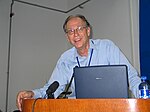| Michael Waterman | |
|---|---|
 Michael Waterman in 2004 Michael Waterman in 2004 | |
| Born | Michael Spencer Waterman June 28, 1942 (1942-06-28) (age 82) Coquille, Oregon, US |
| Alma mater | Oregon State University Michigan State University (PhD) |
| Known for | |
| Awards |
|
| Scientific career | |
| Fields | |
| Institutions | |
| Thesis | Some Ergodic Properties of Multi-Dimensional F-Expansions (1969) |
| Doctoral advisor | John Rankin Kinney |
| Notable students | Pavel Pevzner (postdoc) Tandy Warnow (postdoc) |
| Website | dornsife |
Michael Spencer Waterman (born June 28, 1942) is a Professor of Biology, Mathematics and Computer Science at the University of Southern California (USC), where he holds an Endowed Associates Chair in Biological Sciences, Mathematics and Computer Science. He previously held positions at Los Alamos National Laboratory and Idaho State University.
Education and early life
Waterman grew up near Bandon, Oregon, and earned a bachelor's degree in Mathematics from Oregon State University, followed by a PhD in statistics and probability from Michigan State University in 1969.
Research and career
Waterman is one of the founders and current leaders in the area of computational biology. He focuses on applying mathematics, statistics, and computer science techniques to various problems in molecular biology. His work has contributed to some of the most widely used tools in the field. In particular, the Smith-Waterman algorithm (developed with Temple F. Smith) is the basis for many sequence alignment programs. In 1988, Waterman and Eric Lander published a landmark paper describing a mathematical model for fingerprint mapping. This work formed one of the theoretical cornerstones for many of the later DNA mapping and sequencing projects, especially the Human Genome Project. A 1995 paper by Idury and Waterman introduced Eulerian-De Bruijn sequence assembly which is widely used in next-generation sequencing projects.
With Pavel A. Pevzner (a former postdoctoral researcher in his lab), he began the international conference Research in Computational Molecular Biology (RECOMB), and he is a founding editor of the Journal of Computational Biology. Waterman also authored one of the earliest textbooks in the field: Introduction to Computational Biology.
Awards and honors
With Cyrus Chothia and David Haussler, Waterman was awarded the 2015 Dan David Prize for his contributions to the field of bioinformatics. He was awarded an Honorary Doctorate from Tel Aviv University in 2011, an Honorary Doctorate from the University of Southern Denmark in 2013, and an Honorary Doctorate from Oregon State University in 2024.
Waterman has been a member of the US American Academy of Arts and Sciences since 1995, a member of the US National Academy of Engineering since 2012, a member of the Chinese Academy of Sciences since 2013, and a member of the US National Academy of Sciences since 2001. He has been an academician of the French Academy of Sciences since 2005.
Waterman was elected an ISCB Fellow in 2009 by the International Society for Computational Biology and was awarded their ISCB Senior Scientist Award in 2009.
Personal life
Waterman has written a memoir, Getting Outside, of a childhood spent on an isolated livestock ranch on the southern coast of Oregon in the mid-20th century.
References
- ^ Anon (2017). "Michael S. Waterman: Professor of Biological Sciences, Mathematics, Computer Science, University of Southern California". dornsife.usc.edu/labs/msw. Archived from the original on 2017-02-02.
- ^ Anon (2017). "ISCB Fellows". iscb.org. International Society for Computational Biology. Archived from the original on 2017-03-20.
- ^ Anon (2015). "Misplaced Pages co-founder Jimmy Wales among 2015 Dan David Prize winners". eurekalert.org. Retrieved 13 February 2015.
- ^ Michael Waterman at the Mathematics Genealogy Project
- American Men and Women of Science, Thomson Gale 2005
- ^ Maisel, M. (2006). "ISCB Honors Michael S. Waterman and Mathieu Blanchette". PLOS Computational Biology. 2 (8): e105. Bibcode:2006PLSCB...2..105M. doi:10.1371/journal.pcbi.0020105. PMC 1526462.
- ^ Waterman, Michael (2016). Getting Outside: A Far-Western Childhood. CreateSpace Independent Publishing Platform. ISBN 978-1530929344.
- Waterman, Michael Smith (1969). Some Ergodic Properties of Multi-Dimensional F-Expansions (PhD thesis). Michigan State University. OCLC 25799203. ProQuest 302449931. (subscription required)
- Smith, T.; Waterman, M. S. (1981). "Identification of common molecular subsequences". Journal of Molecular Biology. 147 (1): 195–197. CiteSeerX 10.1.1.63.2897. doi:10.1016/0022-2836(81)90087-5. PMID 7265238.
- Lander, E. S.; Waterman, M. S. (1988). "Genomic mapping by fingerprinting random clones: A mathematical analysis". Genomics. 2 (3): 231–239. doi:10.1016/0888-7543(88)90007-9. PMID 3294162.
- Idury, Ramana M.; Waterman, Michael S. (1995). "A New Algorithm for DNA Sequence Assembly" (PDF). Journal of Computational Biology. 2 (2): 291–306. CiteSeerX 10.1.1.79.6459. doi:10.1089/cmb.1995.2.291. ISSN 1066-5277. PMID 7497130.
- Anon (2017). "The RECOMB conference series". recomb.org.
- Waterman, Michael R.; Waterman, M. S. (1995). Introduction to computational biology: maps, sequences and genomes. London: Chapman & Hall. ISBN 978-0-412-99391-6.
| Fellows of the International Society for Computational Biology by year of election | |
|---|---|
| 2009 | |
| 2010 | |
| 2011 | |
| 2012 | |
| 2013 | |
| 2014 | |
| 2015 | |
| 2016 | |
| 2017 | |
| 2018 | |
| 2019 | |
| 2020 | |
| 2021 | |
| 2022 | |
- Living people
- 1942 births
- People from Bandon, Oregon
- 20th-century American mathematicians
- 21st-century American mathematicians
- American bioinformaticians
- 21st-century American biologists
- University of Southern California faculty
- Idaho State University faculty
- Oregon State University alumni
- Fellows of the Society for Industrial and Applied Mathematics
- Fellows of the International Society for Computational Biology
- Members of the United States National Academy of Engineering
- Members of the United States National Academy of Sciences
- Members of the French Academy of Sciences
- Foreign members of the Chinese Academy of Sciences
- People from Coquille, Oregon
- American statisticians